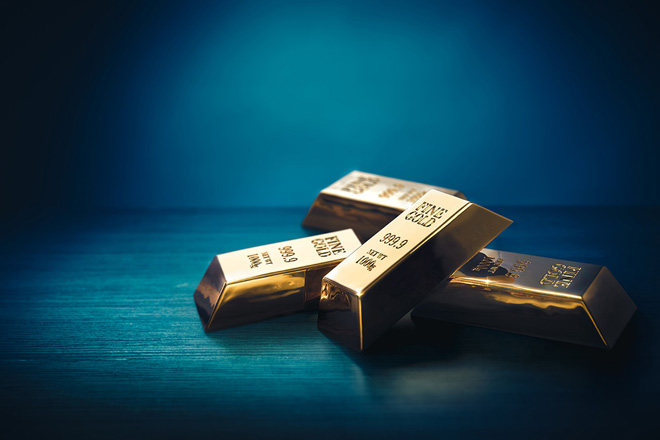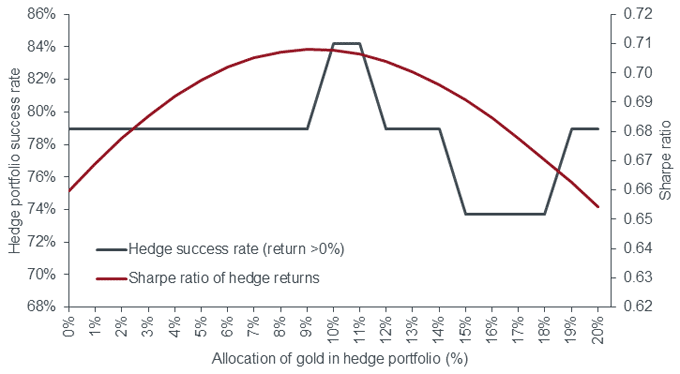Subscribe
Sign up for timely perspectives delivered to your inbox.

”Gold is the corpse of value…Wealth that is stored up in gold is dead. It rots and stinks. True wealth is made every day by men getting up out of bed and going to work. By schoolchildren doing their lessons, improving their minds.” – Neal Stephenson (Cryptonomicon)
How much gold should an investor hold in a well-diversified portfolio? Too small an allocation and even a large price jump won’t make an impact. But too large an allocation is a portfolio drag as the dead money provides no growth and no cash flow.
There are four reasons to hold gold – it keeps up with inflation, especially over the long run, generally rises when equities are falling, hedges local currency risk, and you can trade it for food and guns when the system collapses.
We can’t handicap the end of the world, but bad things do happen occasionally – stock markets fall, currencies get devalued, and bank depositors suffer haircuts. Gold and sovereign bonds are typically the only two assets that benefit from chaos. So there is some diversification value in holding gold to reduce portfolio losses especially if a country’s stocks and bonds are both dropping.
Since the gold standard ended in August 1971 through to August 2017, there have been 19 corrections in the US S&P 500 index (defined as a decline of 10% or more). US government bonds have historically been a decent hedge – the 10-year Treasury has averaged a +6.5% total return during these drawdowns. Gold has also done well rising 9.5% on average.
So what is the best mix of Treasuries and gold during these S&P 500 corrections? Let us optimise for effectiveness (i.e. did the hedge make money) and dispersion (lowest variability of outcomes). The chart below shows the success rate and Sharpe ratio for adding 0%-20% allocation of gold to a hedge portfolio where the only other asset is a 10-year Treasury bond.

Source: Morningstar, Bloomberg, Janus Henderson, September 2017.
The graph shows that both the success rate and Sharpe ratio were highest around a 10% allocation to gold. For example, in a 50/50 equity/bond portfolio replace 10% of the bond portfolio, resulting in 50% equity/45% bonds/5% gold. However, it is worth noting that even the best combination had an 84% success rate during stock market downturns – the hedge is not infallible. There have been rare occasions where stocks, bonds and gold all dropped in unison. Still, pairing up bonds and gold has often resulted in a better hedge against stocks falling than bonds alone.
Notably the above analysis is from the perspective of a US-only investor. However, non-US investors are likely to get a larger benefit from gold. It is often a convenient way to allocate some of their portfolio into US dollars, especially as their local currency government bonds are less likely to rise during times of crisis. Gold is also more attractive in countries with either high inflation or negative cash interest rates.
A completely different approach is to take a leaf from the passive playbook to allocate gold via market capitalisation weights. The World Gold Council estimates the above-ground stock of gold globally is about 187,000 tonnes (6 billion troy ounces) which is currently worth around US$8 trillion. The market capitalisation of all stocks in the world is circa $80 trillion. Size estimates for the global bond market vary widely but most are between $50 and $100 trillion. Taking the midpoint shows a similar result – gold is about 10% of bonds or about 5% of stocks and bonds combined.
Neither method ‘proves’ that you should definitely hold a certain percentage of gold – but are starting points for thinking about allocation within an otherwise risky portfolio. More recently bitcoin has been cited as a ‘hedge’ but its current market capitalisation of around US$75 billion is about the same as Starbucks. Although that is an argument for bitcoin’s potential, for now it is too small for most investors to use as a diversifier. Gold and cockroaches will likely survive the apocalypse, but it is doubtful that bitcoin will.